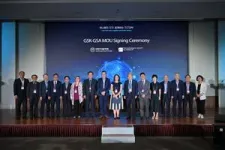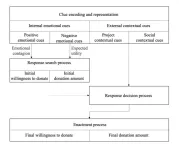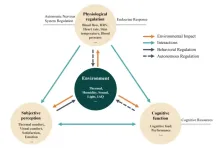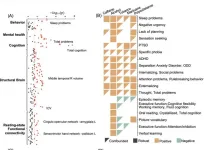Lifetime of ‘biodegradable’ straws in the ocean is 8-20 months, study finds
2024-01-30
(Press-News.org) Plastic drinking straws that get into marine ecosystems make beaches unsightly and pose problems for turtles and seabirds. So, people increasingly favor alternatives marketed as biodegradable or compostable. But do marine microorganisms break apart those straws? Researchers conducted experiments with seawater and report in ACS Sustainable Chemistry & Engineering that some commercial bioplastic or paper straws might disintegrate within eight to 20 months in coastal ocean systems and switching to foam makes a major difference.
To combat plastic pollution, some regions in the U.S. have restricted traditional polymers, such as polypropylene (PP), in drinking straws. These policies have led to a growing market for single-use items made from paper or bioplastics. However, replacement materials need to retain functionality so they don’t flop over after the first sip but will fall apart later if they end up in soil, fresh water or salt water. While the next generation of bioplastics, such as cellulose diacetate (CDA) and polyhydroxyalkanoates (PHA), may be able to meet both requirements, little is known about how long products made of these materials last in the ocean before fully degrading compared to other materials. So, Bryan James, Collin Ward and colleagues conducted experiments using real seawater to investigate the environmental lifetimes of different straws and to find a way to accelerate the breakdown of next-generation bioplastics.
In initial tests, the researchers cut inch-long pieces from commercially available straws made from either coated or uncoated paper, PP polymer, or CDA, PHA or polylactic acid (PLA) bioplastics. Then the pieces were suspended on wires in large tanks with room temperature seawater flowing through them. The team found that after 16 weeks, paper, CDA and PHA straws lost 25-50% of their initial weights. The researchers projected that these degradable straws should fully disintegrate in coastal oceans within 10 months for paper, 15 months for PHA and 20 months for CDA. Additionally, the biofilms on the disintegrating samples contained microbes known to metabolize diverse polymers. Conversely, PP and PLA straws didn’t have measurable weight changes, which suggests they could persist for years in ocean water.
Using the same experimental conditions, the researchers next examined how changing the CDA material’s structure, from solid to a foam, impacted the bioplastic’s environmental lifetime. They observed that the CDA foam broke down at least twice as fast as the solid version, and they estimated that a straw made from the prototype foam would disintegrate in seawater in eight months — the shortest lifetime of any material tested. Having demonstrated that some bioplastic straws are unlikely to remain intact over a long period, the researchers recommend that simple changes, such as switching to foam materials, could further reduce that time frame.
The authors acknowledge funding from Eastman. Some authors are employees of Eastman, a manufacturer of biodegradable plastics.
Some authors have patents in the field of biodegradable plastics.
###
The American Chemical Society (ACS) is a nonprofit organization chartered by the U.S. Congress. ACS’ mission is to advance the broader chemistry enterprise and its practitioners for the benefit of Earth and all its people. The Society is a global leader in promoting excellence in science education and providing access to chemistry-related information and research through its multiple research solutions, peer-reviewed journals, scientific conferences, eBooks and weekly news periodical Chemical & Engineering News. ACS journals are among the most cited, most trusted and most read within the scientific literature; however, ACS itself does not conduct chemical research. As a leader in scientific information solutions, its CAS division partners with global innovators to accelerate breakthroughs by curating, connecting and analyzing the world’s scientific knowledge. ACS’ main offices are in Washington, D.C., and Columbus, Ohio.
To automatically receive news releases from the American Chemical Society, contact newsroom@acs.org.
Note: ACS does not conduct research, but publishes and publicizes peer-reviewed scientific studies.
Follow us: Twitter | Facebook | LinkedIn | Instagram
END
ELSE PRESS RELEASES FROM THIS DATE:
2024-01-30
Washington, D.C.—Tomato juice can kill Salmonella Typhi and other bacteria that can harm people's digestive and urinary tract health, according to research published this week in Microbiology Spectrum, a journal of the American Society for Microbiology. Salmonella Typhi is a deadly human-specific pathogen that causes typhoid fever.
“Our main goal in this study was to find out if tomato and tomato juice can kill enteric pathogens, including Salmonella Typhi, and if so, what qualities they ...
2024-01-30
The 37th International Geological Congress (IGC 2024) in August 2024, Busan, Korea, will highlight a growing concern amid urgent threats posed by accelerated climate and environmental changes. This will prompt collaborative efforts towards ensuring the sustainability of our planet.
Abnormally high temperatures across the globe during the past year were expected to make 2023 the hottest year in Earth's history. This realization underscores the concept of climate change, which was once confined to academic desks but has since permeated into our daily existence.
Geologists now assert that the rapid climate and environmental changes necessitate ...
2024-01-30
Excessive administration of analgesic drugs frequently results in medical accidents. To prevent the occurrence of these accidents, a drug infusion pump featuring a technology for safely detecting medication administration has been developed for the first time in the world.
The research team led by Senior Researcher Dong-kyu Lee of the Korea Institute of Machinery and Materials (President Seog-hyun Ryu, hereinafter referred to as KIMM), an institute under the jurisdiction of the Ministry of Science and ICT, has succeeded in developing the technology for customized sensor modules capable of measuring the extremely low flow rate of analgesic drug infusion pumps as well as the existence ...
2024-01-30
There’s always some truth in fiction, and now is about the time to get a step ahead of sci-fi dystopias and determine what the risk in machine sentience can be for humans.
Although people have long pondered the future of intelligent machinery, such questions have become all the more pressing with the rise of artificial intelligence (AI) and machine learningT. These machines resemble human interactions: they can help problem solve, create content, and even carry on conversations. For fans ...
2024-01-30
Our built environment is aging and failing faster than we can maintain it. Recent building collapses and structural failures of roads and bridges are indicators of a problem that’s likely to get worse, according to experts, because it’s just not possible to inspect every crack, creak and crumble to parse dangerous signs of failure from normal wear and tear. In hopes of playing catch-up, researchers in Drexel University’s College of Engineering are trying to give robotic assistants the tools to help inspectors with the job.
Augmenting visual ...
2024-01-30
The prevalence of Alzheimer’s disease and related dementias (ADRD) is disproportionately high among rural, racially/ethnically diverse older residents. In fact, they face up to an 80 percent greater risk of cognitive impairment in older age, and 2.5 times potentially preventable ADRD-related hospitalizations compared to urban dwellers. It is estimated that early and accurate diagnosis in the mild cognitive impairment stage could save up to $7 trillion in patients’ health and long-term care costs by 2050.
To address these health disparities in rural underserved populations, researchers from Florida ...
2024-01-30
The digital age has profoundly changed how we communicate as humans. Today, we can regularly interact with people we are unrelated to and unacquainted with in real time across the world. Because of this, individuals can now engage in prosocial behaviors, including cooperating, sympathizing, helping and donating, with complete strangers, but the motivating factors behind these behaviors are poorly understood. Analysis of data generated from a fundraising website suggests that positive emotions elicit higher total donation amounts while negative emotions result in higher individual donation amounts.
Fundraising ...
2024-01-30
A lot of factors go into an individual’s comfort, and it’s more than just how one feels about the temperature
The thermal environment refers to the physical surroundings as it pertains to the heat exchange of an individual and its environment. Naturally, the thermal environment also relates to comfort, or more specifically, thermal comfort. This type of comfort is an important metric to measure an individual’s feelings as it relates to their environment and can be directly associated with health, efficiency, comfort, and energy consumption. ...
2024-01-30
COLUMBUS, Ohio – A neighborhood alcohol control project in Sacramento that reduced cases of child abuse and neglect soon after implementation still had a positive impact seven years later, a new study found.
Results showed that, in one of the neighborhoods where the program was put into place, total entries into foster care were reduced by 11.8% and alcohol-related foster care entries were reduced by 11.2% a full seven years after implementation.
These new results were not as strong as those found right after the project was implemented, and there are other caveats to the success of the program. But the results are still very encouraging, said Bridget Freisthler, ...
2024-01-30
An observational study found links between prenatal substance exposure and mental health in children 10–12, but also found that controlling for environment and genetics eliminated many associations. Qiang Luo and colleagues analyzed longitudinal data from almost 10,000 participants in the Adolescent Brain Cognitive Development cohort, looking for associations of maternal self-report of prenatal exposure to caffeine, alcohol, tobacco, and marijuana with mental health outcomes from age 10 to 12. Although the authors found many associations between prenatal exposure to the ...
LAST 30 PRESS RELEASES:
[Press-News.org] Lifetime of ‘biodegradable’ straws in the ocean is 8-20 months, study finds









